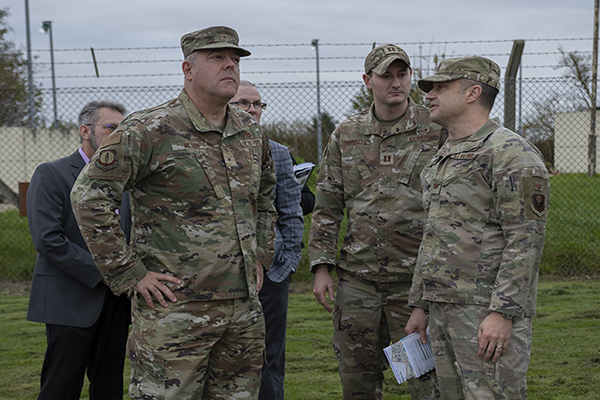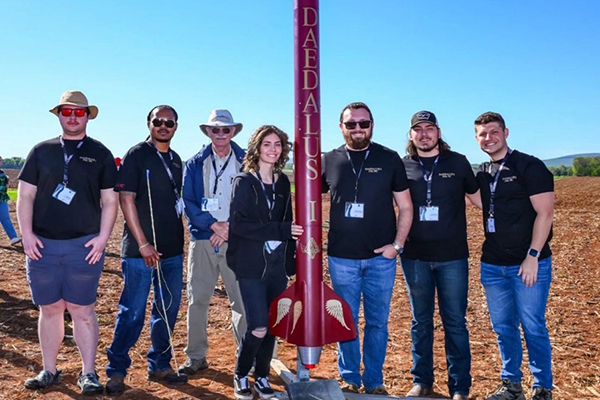By Bill Nieport, RA, PMP, LEED AP, M.SAME, and Rocky Edwards, F.P.E.
In November 2021, the Department of the Air Force released a Sundown Policy for Foam Fire Suppression Systems, which requires the removal of aqueous film-forming foam fire protection systems by October 2024. The mandate was issued after the Departments of the Air Force, Army, and Navy, along with the Defense Logistics Agency, reviewed 32 years of historical information and found that accidental activations of foam systems resulted in 84 incidents over the past 15 years, which together cost the government over $24.5 million and resulted in one death, 21 injuries, and more than 120 aircraft damaged due to interactions with chemicals from the foam.
The sundown policy, and subsequent memorandum that was issued in January 2022, states that, effective immediately, all Air Force hangars and similar facilities equipped with fire suppression systems, categorized as Tier 2 Fire Protection Facilities, must be upgraded to include extra hazard automatic sprinkler systems using water instead of foam. When this policy was released, hangars at Truax Field ANGB, in Madison, Wis., and Selfridge ANGB
in Harrison Township, Mich., were programmed and in design to receive upgrades and undergo alterations. Both projects included new high expansion foam systems, and the alterations at Truax Field were already under construction. With the release of the sundown policy documents, the project needed to be redesigned to include an extra hazard water sprinkler system in limited time.

IMPACTS ON INFRASTRUCTURE
A critical step in the redesign at Truax Field was determining whether the requirements in the new sundown policy conflicted with other government standards for fire protection systems. For example, on peaked or sloped ceilings, smoke collects at the peak and takes time to build back down, which causes delayed activation of the sprinkler system. This delay could mean that the fire already had time to grow. On sloped ceilings, both Unified Facilities Criteria and the National Fire Protection Association standards require a system design with a greater demand for water to account for the possibility of a larger fire before sprinkler activation. However, the sundown documents reference an FM Global standard that does not include a sloped ceiling requirement.
Determining whether these requirements were in conflict was critical. A higher demand for water could directly impact the number and size of fire water storage tanks, piping, and pumps. When approaching the technical problems presented in implementing the sundown policy, it is important to step back and look at a flightline’s firefighting water supply, as well as any shared sanitary discharge systems for design and cost impacts beyond the building’s footprint. Compliance of a single facility is often approached as a silo, without analyzing the impact to shared or adjacent services. The water supply and drainage systems for existing hangars, other interconnected flightline hangars, and pump systems should be areas of focus for early assessment teams.
Flow demands for extra hazard sprinkler systems are very high, with some at or above 2,500-gal/min. The driving factor is ceilings, which are high and sloped in hangar bays. These high flows often result in the need for significant upgrades to the site water infrastructure—including high-cost items such as aboveground water storage tanks, enlarged fire pumps, larger underground water service mains, and any site improvements that are in the way of the project. Where the water service is on a dedicated flightline hangar high pressure loop, water service upgrades may impact multiple facilities.
Large fire suppression systems may also need electrical primary and secondary service infrastructure upgrades to support a larger pump and generator for backup power. Finally, since new fire pumps must be in conditioned spaces and may not fit in the existing space available, a new pump house could be required.
While it is likely that significant upgrades will be needed in the fire suppression system, it is not always the case. At Truax Field, the design used the existing pump. This kept costs down and helped maintain the schedule since a large pump redesign was not needed.
LOWERING THE LEARNING CURVE
The experience implementing the sundown policy at Truax Field would provide a head start at Selfridge. With the benefit of previous clarifications on the policy by the Air Force Civil Engineer Center, the project team was able to accurately identify design changes, time impacts, and a revised working estimate. Engineers, for example, knew that the extra hazard automatic sprinkler system required a significant amount of water due to a high flow rate. The greater water capacity would affect the pipe sizing for the sprinkler systems in the hangar bay. It was expected the sprinkler riser, mains, and branch piping would need to be replaced with larger pipes to accommodate the higher sprinkler density.
Designers conducted site investigations, which included hydraulic assessments, evaluations, and calculations, to accurately identify necessary changes. New hydrant flow tests and fire pump flow tests assessed what impacts the system would have on big-ticket items. In addition to speeding up the process, understanding how the greater water flows could affect the critical components of the design allowed for a more accurate schedule and cost model.
Triple IR flame detection was still required in the hangar bays, but detectors needed to be installed around the perimeter and all portions of the hangar were to be visible by at least two detectors. Previously, UFC 4-211-01 had required that all portions of the hangar bay be visible by at least three detectors. The existing hangars at Selfridge were already compliant in flame detection, which allowed the flame detectors to remain in their current locations.
Expert knowledge of fire safety codes and standards positively affected the projects at Truax Field and Selfridge. The team’s ability to quickly assess the differences between existing standards and the new sundown policy allowed it to compile an extensive list of requests-for-information, receive clarifications, and mobilize quickly, which was critical to the project. In doing so, not only was the project schedule maintained, but cost-effective, high-quality designs were implemented. Both the Truax Field and Selfridge fire protection system designs were submitted, reviewed, and approved with no technical comments or refinements.
PLANNING FOR THE FUTURE
The congressionally mandated removal of foam systems by October 2024 will require aggressive schedules. However, planning ahead now for its implementation can set teams up for success.
Early site investigation can collapse the schedule. Situations discovered in the initial inspection can present conflicts in code or impacts to adjacent infrastructure that will take time to resolve with the jurisdiction authority. Fire flow tests, pressure and flow analyses, and upgrade assessments should be performed as early as possible, allowing time for the architect-engineer to review findings and cross check them against the requirements in the sundown policy.
Changes to the water flow requirements can have significant impacts on the entire flightline fire protection system. Proactive consideration of adjacent hangars and system-wide water service improvements that may be required is essential. Reprogramming for additional supporting site infrastructure may also be required. Understanding the sundown policy and its interaction with other codes and standards will be essential to completing high-quality projects within the stated timeframe. A fire protection engineering team with expertise across codes as well as converting systems to comply with the sundown policy can more accurately and quickly anticipate and interpret design, cost, and schedule impacts.
Related Posts
-

Leading the Way: Partnering for Resiliency and Readiness
TME Interview with Brig. Gen. Patrick Miller, P.E., F.SAME, USAF Commander, Air Force Civil Engineer Center -

Developing Tomorrow’s STEM Workforce Through Partnership
TME recently interviewed leaders of the Panama City Post about paying it forward, their repertoire of STEM outreach, and the benefits of collaborating with similar-minded professional organizations. -

Electrifying Solutions for Military Installations
As military installations implement electrification measures into the future, the challenges they face will not just require innovative technology solutions but embracing a holistic delivery approach implemented early in projects.